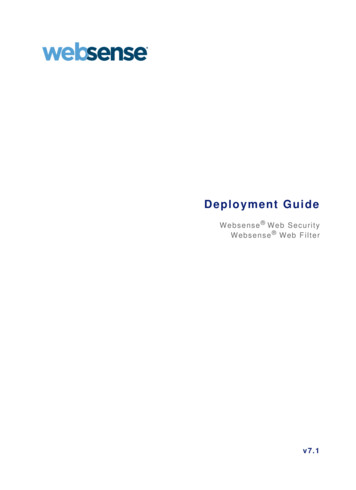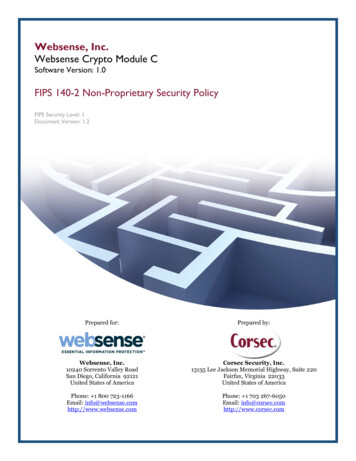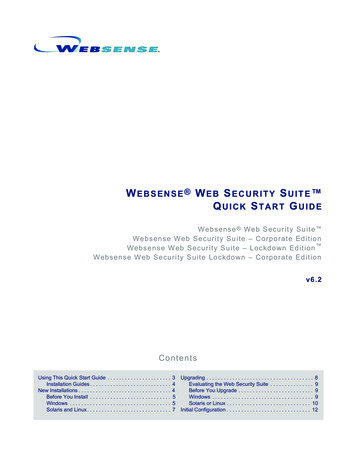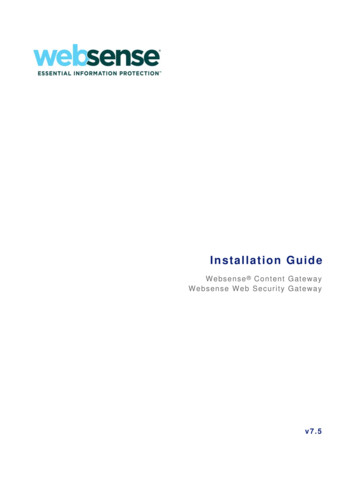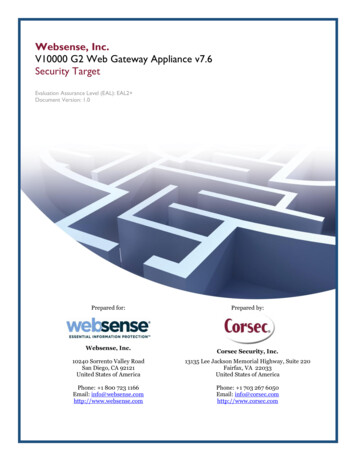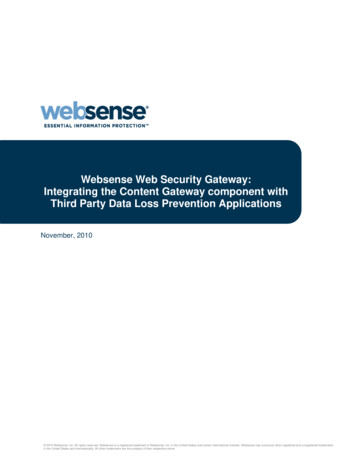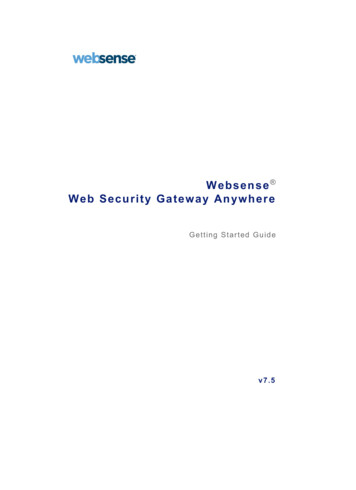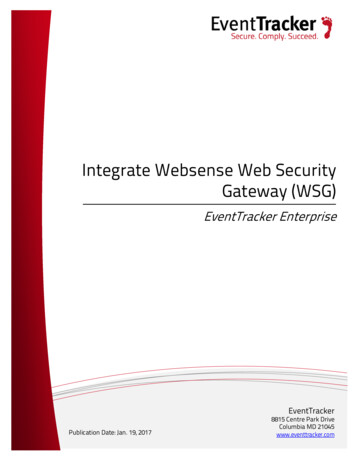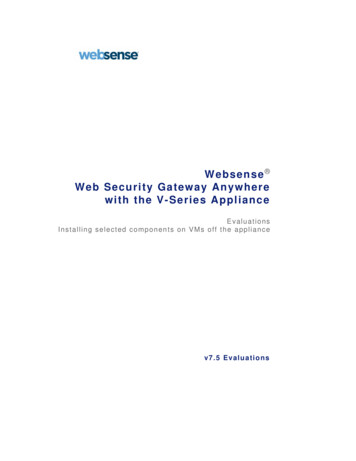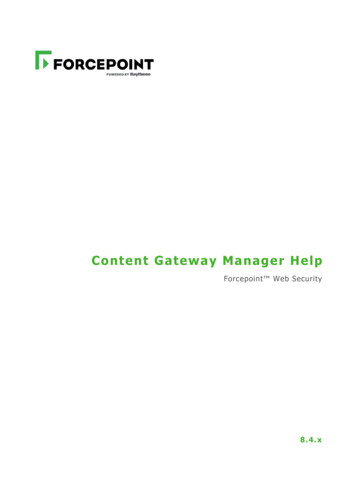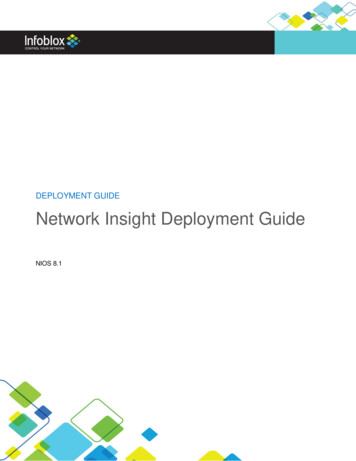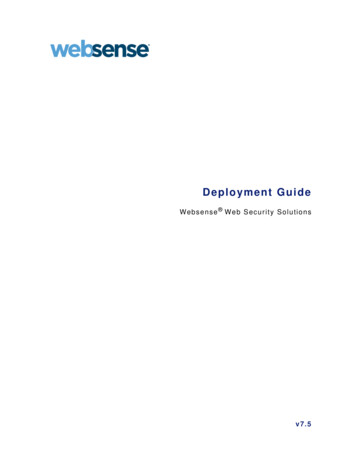
Transcription
Deployment GuideWebsense Web Security Solutionsv7.5
1996–2010, Websense, Inc.All rights reserved.10240 Sorrento Valley Rd., San Diego, CA 92121, USAPublished 2010Printed in the United States of America and IrelandThe products and/or methods of use described in this document are covered by U.S. Patent Numbers 6,606,659 and 6,947,985 and other patentspending.This document may not, in whole or in part, be copied, photocopied, reproduced, translated, or reduced to any electronic medium or machinereadable form without prior consent in writing from Websense Inc.Every effort has been made to ensure the accuracy of this manual. However, Websense Inc., makes no warranties with respect to thisdocumentation and disclaims any implied warranties of merchantability and fitness for a particular purpose. Websense Inc. shall not be liable forany error or for incidental or consequential damages in connection with the furnishing, performance, or use of this manual or the examples herein.The information in this documentation is subject to change without notice.TrademarksWebsense is a registered trademark of Websense, Inc. in the United States and certain international markets. Websense has numerous otherunregistered trademarks in the United States and internationally. All other trademarks are the property of their respective owners.Microsoft, Windows, Windows NT, Windows Server, Internet Explorer, and Active Directory are either registered trademarks or trademarks ofMicrosoft Corporation in the United States and/or other countries.Sun, Sun Java System, Sun ONE, and all Sun Java System based trademarks and logos are trademarks or registered trademarks of SunMicrosystems, Inc., in the United States and other countries.Mozilla and Firefox are registered trademarks of the Mozilla Foundation in the United States and/or other countries.Novell is a registered trademark, and eDirectory is a trademark, of Novell, Inc., in the United States and other countries.Adobe, Acrobat, and Acrobat Reader are either registered trademarks or trademarks of Adobe Systems Incorporated in the United States and/orother countries.Pentium is a registered trademark of Intel Corporation.Red Hat is a registered trademark of Red Hat, Inc., in the United States and other countries. Linux is a trademark of Linus Torvalds, in the UnitedStates and other countries.Citrix, Citrix Presentation Server, and MetaFrame are trademarks or registered trademarks of Citrix Systems, Inc. and/or one or more of itssubsidiaries, and may be registered in the United States Patent and Trademark Office and in other countries.Cisco, Cisco Systems, Cisco PIX Firewall, Cisco IOS, Cisco Routers, and Cisco Content Engine are registered trademarks or trademarks of CiscoSystems, Inc., in the United States and certain other countries.Check Point, OPSEC, FireWall-1, VPN-1, SmartDashboard, and SmartCenter are trademarks or registered trademarks of Check Point SoftwareTechnologies Ltd. or its affiliates.Inktomi, the Inktomi logo, and Inktomi Traffic Server are registered trademarks of Inktomi Corporation.This product includes software distributed by the Apache Software Foundation (http://www.apache.org).Copyright (c) 2000. The Apache Software Foundation. All rights reserved.Other product names mentioned in this manual may be trademarks or registered trademarks of their respective companies and are the sole propertyof their respective manufacturers.
ContentsList of Figures . . . . . . . . . . . . . . . . . . . . . . . . . . . . . . . . . . . . . . . . . . . . . . . . . . . . . . . . . . . . . . . . 5Chapter 1Introduction . . . . . . . . . . . . . . . . . . . . . . . . . . . . . . . . . . . . . . . . . . . . . . . . . . . . . 7Websense Components. . . . . . . . . . . . . . . . . . . . . . . . . . . . . . . . . . . . . . . . . . . . . . 9Chapter 2General Deployment Recommendations . . . . . . . . . . . . . . . . . . . . . . . . . . . . . 15Operating system requirements . . . . . . . . . . . . . . . . . . . . . . . . . . . . . . . . . . . . . . 16Network considerations . . . . . . . . . . . . . . . . . . . . . . . . . . . . . . . . . . . . . . . . . . . . 21Component limits . . . . . . . . . . . . . . . . . . . . . . . . . . . . . . . . . . . . . . . . . . . . . . . . 22Multiple TRITON - Web Security instances. . . . . . . . . . . . . . . . . . . . . . . . . . 23Multiple Directory Agent instances . . . . . . . . . . . . . . . . . . . . . . . . . . . . . . . . 23Component ratios . . . . . . . . . . . . . . . . . . . . . . . . . . . . . . . . . . . . . . . . . . . . . . . . . 24Required external resources . . . . . . . . . . . . . . . . . . . . . . . . . . . . . . . . . . . . . . . . . 26Supported directory services . . . . . . . . . . . . . . . . . . . . . . . . . . . . . . . . . . . . . . 27Deploying transparent identification agents. . . . . . . . . . . . . . . . . . . . . . . . . . . . . 27Combining transparent identification agents. . . . . . . . . . . . . . . . . . . . . . . . . . 28Maximizing system performance . . . . . . . . . . . . . . . . . . . . . . . . . . . . . . . . . . . . . 30Stand-alone deployments . . . . . . . . . . . . . . . . . . . . . . . . . . . . . . . . . . . . . . . . . . . 35Remote Filtering Server and Client . . . . . . . . . . . . . . . . . . . . . . . . . . . . . . . . . . . 37Supported integrations . . . . . . . . . . . . . . . . . . . . . . . . . . . . . . . . . . . . . . . . . . . . . 40Chapter 3Deploying Network Agent . . . . . . . . . . . . . . . . . . . . . . . . . . . . . . . . . . . . . . . . . 43Network Agent . . . . . . . . . . . . . . . . . . . . . . . . . . . . . . . . . . . . . . . . . . . . . . . . . . . 44Network Agent location . . . . . . . . . . . . . . . . . . . . . . . . . . . . . . . . . . . . . . . . . . . . 45Single segment network . . . . . . . . . . . . . . . . . . . . . . . . . . . . . . . . . . . . . . . . . . . . 46Multiple segment network . . . . . . . . . . . . . . . . . . . . . . . . . . . . . . . . . . . . . . . . . . 47Hub configuration. . . . . . . . . . . . . . . . . . . . . . . . . . . . . . . . . . . . . . . . . . . . . . . . . 50Switched networks with a single Network Agent . . . . . . . . . . . . . . . . . . . . . . . . 51Switched networks with multiple Network Agents . . . . . . . . . . . . . . . . . . . . . . . 54Gateway configuration . . . . . . . . . . . . . . . . . . . . . . . . . . . . . . . . . . . . . . . . . . . . . 55Using multiple NICs. . . . . . . . . . . . . . . . . . . . . . . . . . . . . . . . . . . . . . . . . . . . . . . 57NAT and Network Agent deployment . . . . . . . . . . . . . . . . . . . . . . . . . . . . . . . . . 58Chapter 4Web Security Gateway Anywhere Deployments . . . . . . . . . . . . . . . . . . . . . . . 59Web Security Gateway Anywhere . . . . . . . . . . . . . . . . . . . . . . . . . . . . . . . . . . . . 59Deployment Guide 3
Appliance configuration . . . . . . . . . . . . . . . . . . . . . . . . . . . . . . . . . . . . . . . . . 60Software configuration . . . . . . . . . . . . . . . . . . . . . . . . . . . . . . . . . . . . . . . . . . 62Websense Content Gateway requirements . . . . . . . . . . . . . . . . . . . . . . . . . . . 62Data Security Management Server requirements . . . . . . . . . . . . . . . . . . . . . . 64Network diagram - appliance . . . . . . . . . . . . . . . . . . . . . . . . . . . . . . . . . . . . . . . . 65Network diagram - software. . . . . . . . . . . . . . . . . . . . . . . . . . . . . . . . . . . . . . . . . 65Chapter 5Integration Deployment . . . . . . . . . . . . . . . . . . . . . . . . . . . . . . . . . . . . . . . . . . . 67Websense Content Gateway . . . . . . . . . . . . . . . . . . . . . . . . . . . . . . . . . . . . . . . . . 68Microsoft ISA Server or Forefront TMG . . . . . . . . . . . . . . . . . . . . . . . . . . . . . . . 70Cisco deployment . . . . . . . . . . . . . . . . . . . . . . . . . . . . . . . . . . . . . . . . . . . . . . . . . 74Check Point . . . . . . . . . . . . . . . . . . . . . . . . . . . . . . . . . . . . . . . . . . . . . . . . . . . . . 77Squid Web Proxy Cache deployment. . . . . . . . . . . . . . . . . . . . . . . . . . . . . . . . . . 79Citrix. . . . . . . . . . . . . . . . . . . . . . . . . . . . . . . . . . . . . . . . . . . . . . . . . . . . . . . . . . . 84Universal integration . . . . . . . . . . . . . . . . . . . . . . . . . . . . . . . . . . . . . . . . . . . . . . 86Chapter 6Distributed Enterprise Deployments . . . . . . . . . . . . . . . . . . . . . . . . . . . . . . . . 87Basic Network Topology . . . . . . . . . . . . . . . . . . . . . . . . . . . . . . . . . . . . . . . . . . . 88Websense Web Security and Web Security Gateway. . . . . . . . . . . . . . . . . . . 88Websense Web Security Gateway Anywhere. . . . . . . . . . . . . . . . . . . . . . . . . 90Filtering Remote Sites. . . . . . . . . . . . . . . . . . . . . . . . . . . . . . . . . . . . . . . . . . . 91Deployment models . . . . . . . . . . . . . . . . . . . . . . . . . . . . . . . . . . . . . . . . . . . . . . . 94Sites in a region . . . . . . . . . . . . . . . . . . . . . . . . . . . . . . . . . . . . . . . . . . . . . . . . 95Expanding sites in a region . . . . . . . . . . . . . . . . . . . . . . . . . . . . . . . . . . . . . . . 96National or worldwide offices. . . . . . . . . . . . . . . . . . . . . . . . . . . . . . . . . . . . . 97Secure VPN connections . . . . . . . . . . . . . . . . . . . . . . . . . . . . . . . . . . . . . . . . . . 100Calculating TCP connections . . . . . . . . . . . . . . . . . . . . . . . . . . . . . . . . . . . . . . . 100Calculating connections . . . . . . . . . . . . . . . . . . . . . . . . . . . . . . . . . . . . . . . . 101Optimizing network performance. . . . . . . . . . . . . . . . . . . . . . . . . . . . . . . . . . . . 103Internet Connection Speed . . . . . . . . . . . . . . . . . . . . . . . . . . . . . . . . . . . . . . 104Distance from the Websense filtering machine. . . . . . . . . . . . . . . . . . . . . . . 104Hardware performance . . . . . . . . . . . . . . . . . . . . . . . . . . . . . . . . . . . . . . . . . 105Index . . . . . . . . . . . . . . . . . . . . . . . . . . . . . . . . . . . . . . . . . . . . . . . . . . . . . . . . . . . . . . . . . . . . . . . 1074 WebsenseWeb Security Solutions
List of FiguresFigure 1:Figure 2:Figure 3:Figure 4:Figure 5:Figure 6:Figure 7:Figure 8:Figure 9:Figure 10:Figure 11:Figure 12:Figure 13:Figure 14:Figure 15:Figure 16:Figure 17:Figure 18:Figure 19:Figure 20:Figure 21:Figure 22:Figure 23:Figure 24:Figure 25:Figure 26:Figure 27:Figure 28:Figure 29:Figure 30:Figure 31:Figure 32:Figure 33:Example of Remote Filtering Deployment .39Websense software in a single-segment network .46Websense software in a multiple-segment network .48Multiple Network Agents in a multiple-segment network .49Network Agent connected to a hub.50Simple deployment in a switched environment .51Multiple segments in a switched environment .52Switched environment with a remote office connection .53Multiple Network Agents in a switched environment .54Network Agent installed on the gateway .55Network Agent deployed with Websense Content Gateway.56Dual NIC configuration .58Websense Web Security Gateway Anywhere on appliance .65Websense Web Security Gateway Anywhere as software .65Integration with Websense Content Gateway.69Filtering components installed with Microsoft ISA Server .71Filtering components installed separately from Microsoft ISA Server/ForefrontTMG72Microsoft ISA Server/Forefront TMG array configuration .73Common Windows Network Configuration for Cisco PIX Firewall or ASA .74Common Windows network configuration for Cisco Content Engine.75Common Windows network configuration for Cisco IOS Routers .76Simple network configuration .77Multi-segment network configuration .78Filtering components installed with Squid Web Proxy Cache .80Filtering components and Squid Web Proxy Cache on separate machines .81Squid Web Proxy Cache array configuration #1 .82Squid Web Proxy Cache array configuration #2 .83Citrix integration.85Common network configuration .86Remote site topology in a decentralized network (Websense Web Security) .88Remote site topology in a decentralized network (Websense Web SecurityGateway)89Remote site topology in a decentralized network (Websense Web SecurityGateway Anywhere)90Filtering a remote-site client machine (Websense Web Security and WebSecurity Gateway)92Deployment Guide 5
Figure 34: Filtering a remote-site client machine (Websense Web Security GatewayAnywhere)93Figure 35: Multiple offices in a region.95Figure 36: Multiple sites in a region .96Figure 37: Single main site, multiple remote sites(Websense Web Security Gateway Anywhere)98Figure 38: Multiple large sites (Websense Web Security Gateway Anywhere) .996 WebsenseWeb Security Solutions
1IntroductionUse this guide to plan your Websense software deployment before installation. Theguide provides an overview of how Websense software can be deployed in a network,as well as operating system and hardware requirements.This guide applies to version 7.5 of Websense Web Security Gateway Anywhere, WebSecurity Gateway, Websense Web Security, and Websense Web Filter. The termWebsense software is used to refer to all or any of these solutions. When informationor instructions apply to particular solutions, they are referred to individually by name.NoteThe technical papers and other documents mentioned inthis guide are available from the Documentation Planning, Installation, and Upgrade folder in the WebsenseKnowledge Base (www.websense.com/docs).Websense software consists of components that work together to monitor Internetrequests, log activity, apply Internet usage filters, and report on activity. Websensesoftware is highly-distributable, providing the flexibility to scale a deployment to suityour needs. Components can be installed together on one machine for smallerorganizations; or they can be distributed across mutliple machines, and multiple sites,to create a high-performing deployment for larger organizations. The appropriatedeployment is determined by network size and configuration, Internet request volume,hardware performance, and filtering needs.This manual provides system recommendations to optimize Websense componentperformance. Performance can also be improved by using more powerful machinesfor resource-intensive components.This chapter introduces Websense filtering, reporting, and interoperabilitycomponents. See also: Chapter 2: General Deployment Recommendations—operating systemrequirements for running Websense components, component limits, tips formaximizing performance, plus recommendations for deploying transparentidentification agents, Remote Filtering, and Websense software as a stand-aloneinstallation. Version requirements are also included for various integrations.Deployment Guide 7
Introduction Chapter 3: Deploying Network Agent—information for deploying across singleand multiple segment networks. Also provides Network Agent placement details,settings, and relationship to hubs, switches, and gateways. Chapter 4: Web Security Gateway Anywhere Deployments—description ofmodules in addition to Websense Web Security, including Websense ContentGateway, Websense Data Security Management Server, Websense Sync Service,and Websense Directory Agent. Chapter 5: Integration Deployment—overview of deploying Websense softwarewith firewalls, proxy servers, caching applications, network appliances, or otherintegration products or devices.For Websense Content Gateway deployment information see the Deploying withWebsense Content Gateway supplement. The gateway provides Web and proxycaching, dynamic classification of Web sites, Web 2.0 categorization, and an optionalSSL manager. See the Websense Content Gateway documentation for moreinformation on this product.NotePlease contact Websense Sales Engineering for assistancein designing your Websense software deployment. A SalesEngineer can help you optimize Websense componentdeployment and understand the associated hardware needs.8 Websense Web Security Solutions
IntroductionWebsense ComponentsTable 1 provides a brief description of the Websense components. This table groupsthe components into core (included in a standard deployment), reporting, optional,and interoperability (allowing communication and interaction between Web securitycomponents, data security components, and the hybrid service in a Websense WebSecurity Gateway Anywhere deployment).Review these descriptions to better understand the interaction between components.See Table 2, on page 16, and Table 3, on page 20, for information on the operatingsystem versions needed to run these components.NOTECertain integrations include Websense filtering plug-ins.These are discussed in Table 7, on page 40.Table 1 Websense ComponentsComponentDefinitionCore ComponentsPolicy DatabaseStores global Websense software settings (configured inTRITON - Web Security) and policy information (includingclients, filters, and filter components). Policy Database is installed in the background with PolicyBroker. Policy Database stores policy-related data; configurationdata is stored separately, by Policy Server.In multiple Policy Server environments, a single PolicyDatabase holds policy and general configuration data formultiple Policy Servers.Policy BrokerManages requests from Websense components for policy andgeneral configuration information stored in the PolicyDatabase.A deployment can have only one Policy Broker, which isbundled with Policy Database.Deployment Guide 9
IntroductionTable 1 Websense ComponentsComponentDefinitionPolicy ServerIdentifies and tracks the location and status of otherWebsense components in a deployment. Logs event messages for Websense components. Stores configuration information specific to a single PolicyServer instance. Communicates configuration data to Filtering Service foruse in filtering Internet requests.Policy and most configuration settings are shared betweenPolicy Servers that share a Policy Database.Policy Server is typically installed on the same machine asFiltering Service. Large or distributed environments caninclude multiple Policy Servers. Each Policy Server maycommunicate with up to 10 Filtering Services (see FilteringServices per Policy Server, page 25).Filtering ServiceWorks with Network Agent or an integration product toprovide Internet filtering. When a user requests a site, FilteringService receives the request and determines which policyapplies. Filtering Service must be running for Internet requests tobe filtered and logged. Each Filtering Service instance downloads its own co
This guide applies to version 7.5 of Websense Web Security Gateway Anywhere, Web Security Gateway, Websense Web Security, and Websense Web Filter. The term Websense software is used to refer to all or any of these solutions. When information or instructions apply to particu
